|
|
• • •
In partnership with the
Greater Toronto Airports Authority, Peel Regional Police & Royal Canadian Mounted Police
  
|
Tours & EventsBack to Tours & Events main page |
Pearson Airport Fire Station
On August 14, 2006 members of the YYZ Airport Watch were back at our home base for a tour of the GTAA Fire and Emergency Services. 20 members participated in an outstanding tour of the "North"- Station 2 fire hall. Pearson Airport currently has 2 fire stations, the second is located at the south end of the airport. A third station is being constructed near Courtneypark Dr. along with the new fire training academy.
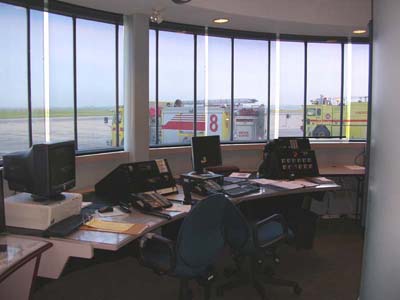 Our tour began with a briefing in the "Alarm Room" which contains the stations communications and computer equipment. An excellent panoramic view of the stations ramp area and aircraft activity on runway 23-05 made for the perfect backdrop. Our host, Firefighter Andy Armstrong welcomed our group and gave an excellent speech on the operations and nature of airport firefighting. Pearson Airport is a city onto itself, and like in any city there are a multitude of situations that arise requiring the services of these trained professionals. Some may envision the airport fire services are strictly for aircraft emergencies, nothing could be farther from the truth. Medical emergencies, vehicle accidents, hazardous material spills are all in a days work for these crews. In addressing one of the differences between the airport fire department and say one such as the Toronto Fire Service, airport fire crews are often responding to a situation that hasn't yet happened. An aircraft with an in-flight emergency may be several minutes from touchdown. By this time airport fire crews will have already responded to the runway to take up their positions and be at the ready to assist. Other urban fire departments in most cases arrive on the scene to a fully involved incident. Pearson Airport fire crews responded to some 4333 calls in 2005 alone. Following Andy's speech our group were given instructions on what to do in the event that the crews had to respond on a call. From the alarm room it was time to visit the apparatus. Our tour began with a briefing in the "Alarm Room" which contains the stations communications and computer equipment. An excellent panoramic view of the stations ramp area and aircraft activity on runway 23-05 made for the perfect backdrop. Our host, Firefighter Andy Armstrong welcomed our group and gave an excellent speech on the operations and nature of airport firefighting. Pearson Airport is a city onto itself, and like in any city there are a multitude of situations that arise requiring the services of these trained professionals. Some may envision the airport fire services are strictly for aircraft emergencies, nothing could be farther from the truth. Medical emergencies, vehicle accidents, hazardous material spills are all in a days work for these crews. In addressing one of the differences between the airport fire department and say one such as the Toronto Fire Service, airport fire crews are often responding to a situation that hasn't yet happened. An aircraft with an in-flight emergency may be several minutes from touchdown. By this time airport fire crews will have already responded to the runway to take up their positions and be at the ready to assist. Other urban fire departments in most cases arrive on the scene to a fully involved incident. Pearson Airport fire crews responded to some 4333 calls in 2005 alone. Following Andy's speech our group were given instructions on what to do in the event that the crews had to respond on a call. From the alarm room it was time to visit the apparatus.
If mega machines get you excited then the fire fighting apparatus are for you. These trucks are nothing short of amazing. The shear size and performance of these vehicles is most impressive. Station 2 is home to 6 front line vehicles ranging from Aircraft Rescue Fire Fighting, a Structural Pumper, a mini Rescue and mini Pumper trucks. Andy gave our group an in depth speech and close up look at each of the trucks in the station. 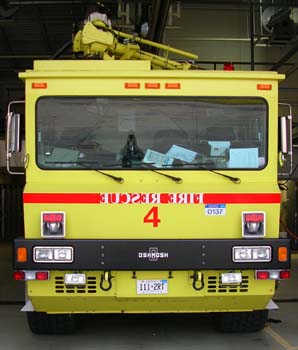 The capabilities of these vehicles is simply awesome, the amount of water and/or foam they can discharge in just minutes would fill a swimming pool in no time. One of the most interesting facts about the major crash trucks is the manpower, or should I say how few men are required to operate them. One person can drive and operate the water cannon with the controls that are all located inside the driver cab. Obviously not necessarily at the same time though. The capabilities of these vehicles is simply awesome, the amount of water and/or foam they can discharge in just minutes would fill a swimming pool in no time. One of the most interesting facts about the major crash trucks is the manpower, or should I say how few men are required to operate them. One person can drive and operate the water cannon with the controls that are all located inside the driver cab. Obviously not necessarily at the same time though.
The windows on the crash vehicles are many times stronger then regular glass and are made from a super thick composition for protection from heat and debris. Red 6 & Red 3 have an interesting water nozzle system. Along with a standard water nozzle, they are also equipped with a piercing rod that allows crews to actually penetrate an aircraft fuselage and discharge water into the interior of an aircraft through this piercing rod. Both vehicles also have an infrared camera on the water nozzle boom. Major crash vehicles are equipped with additional water nozzles that are located underneath the trucks themselves. This allows for water discharge under and around the vehicle itself preventing burning fluids on the ground from reaching the truck. As our group finished up the rounds of the various apparatus, Red 2 was returning to the station after refueling and was preparing for a demonstration of a different kind.
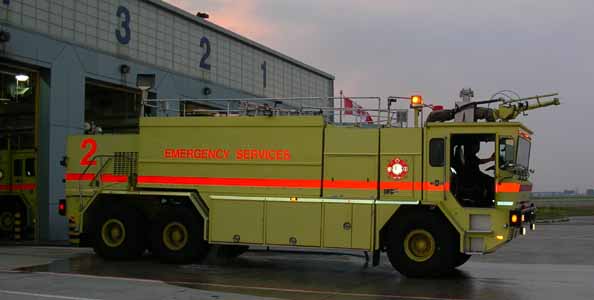 Positioned outside on the station ramp, Firefighter Brad Lavery in Red 2, took the controls and gave us a demonstration of the business end of this vehicle. A full on water cannon display, and if you think a 38mm line from a regular fire truck sprays a lot of water, this beast makes that look like a garden hose. With the nozzle now in full operation, the stream of water was easily reaching 50 yards. Any aircraft on Juliet taxiway could have had a free wash. These trucks are designed to discharge water and/or foam and a lot of it, FAST!! With the stream of water flowing overhead what a better time then a group photo opportunity. Even standing off to the side some 5-10 feet away from the front of the truck, the mist was easily showering a few of us. Having never been that close to one of these trucks while they were in operation, I have to say this was most impressive and a real highlight for us. As our group moved back inside the station it was time to see if any of us had what it takes to be a firefighter, well at least what one of us would look like in the gear. Positioned outside on the station ramp, Firefighter Brad Lavery in Red 2, took the controls and gave us a demonstration of the business end of this vehicle. A full on water cannon display, and if you think a 38mm line from a regular fire truck sprays a lot of water, this beast makes that look like a garden hose. With the nozzle now in full operation, the stream of water was easily reaching 50 yards. Any aircraft on Juliet taxiway could have had a free wash. These trucks are designed to discharge water and/or foam and a lot of it, FAST!! With the stream of water flowing overhead what a better time then a group photo opportunity. Even standing off to the side some 5-10 feet away from the front of the truck, the mist was easily showering a few of us. Having never been that close to one of these trucks while they were in operation, I have to say this was most impressive and a real highlight for us. As our group moved back inside the station it was time to see if any of us had what it takes to be a firefighter, well at least what one of us would look like in the gear.
 By unanimous decision, Airport Watch member Kimberly Paul was chosen to don the gear. Assisted by Firefighter Andy Armstrong the transformation from tour participant to fire women began. With helmet, pants, jacket, boots, and even the oxygen back pack, Kim was ready to take on the task of airport firefighting. As our 2 hour tour was coming to a close a quick look around the crew quarters and closing comments from Andy, Brad, and Platoon Chief Harston capped off an excellent event. By unanimous decision, Airport Watch member Kimberly Paul was chosen to don the gear. Assisted by Firefighter Andy Armstrong the transformation from tour participant to fire women began. With helmet, pants, jacket, boots, and even the oxygen back pack, Kim was ready to take on the task of airport firefighting. As our 2 hour tour was coming to a close a quick look around the crew quarters and closing comments from Andy, Brad, and Platoon Chief Harston capped off an excellent event.
The knowledge, dedication, and pride these firefighters have is second to none. Firefighting is a profession like no other and during our tour we learned about many of the complexities and uniqueness of airport fire fighting. We as passengers hope we never require their services, but it is comforting to know that this team of professionals are at the ready.
Station 2 Apparatus Roster
Red 2 - 1994 Oshkosh T-3000 Major Foam Vehicle
Red 4 - 1998 Oshkosh T-1500 Rapid Intervention Vehicle
Red 6 - 1998 Oshkosh T-3000 Rescue Fire Fighting Snozzle
Red 7 - 1998 Ford F550 - Mini Rescue
Red 8 - 2000 Superior - Structural Pumper
Red 12 - 2002 GMC 3500 - Mini-Pumper
Our sincere thanks go out to "B" Platoon Chief Peter Harston and Firefighters Andy Armstrong and Brad Lavery for a superb and interesting tour. Next time you're out at YYZ and see the trucks, give the crews a wave.
Photos courtesy of Andy Cline, Ken Keen, Craig Rae & Parr Yonemoto
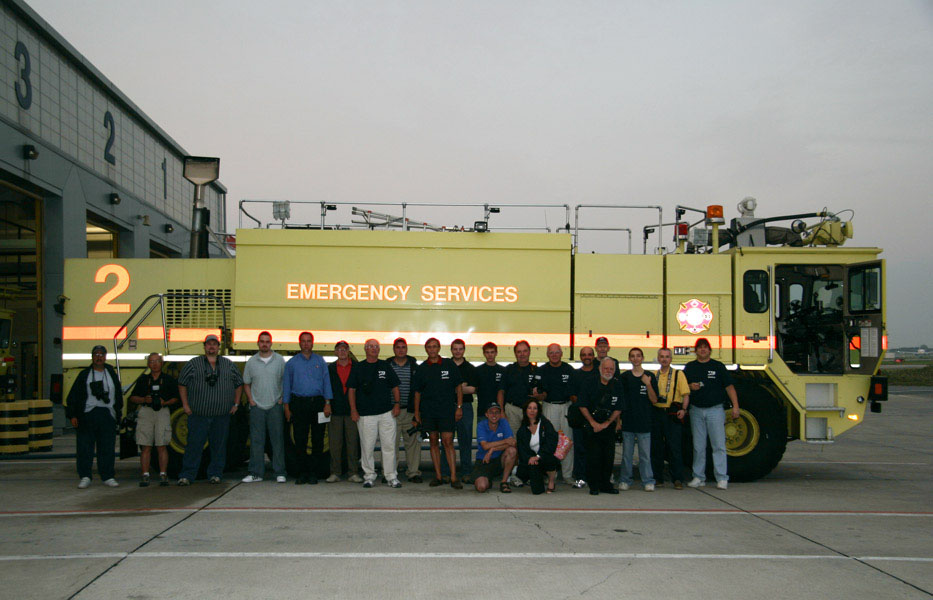
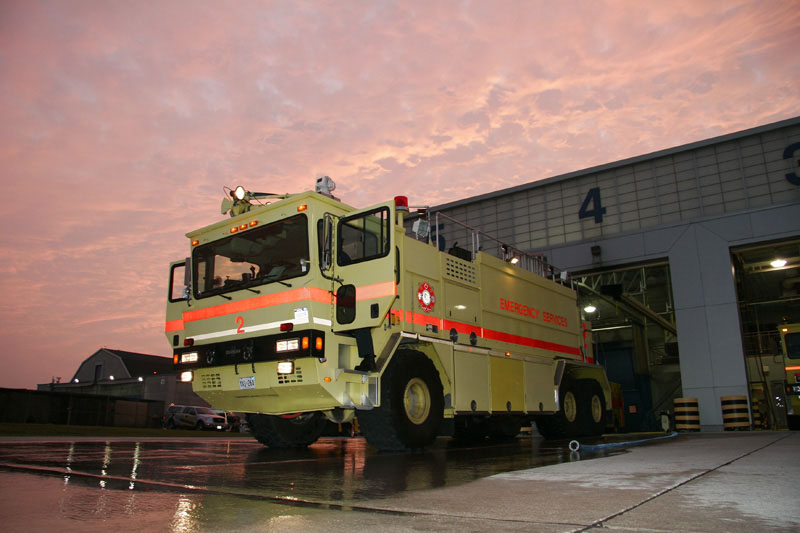
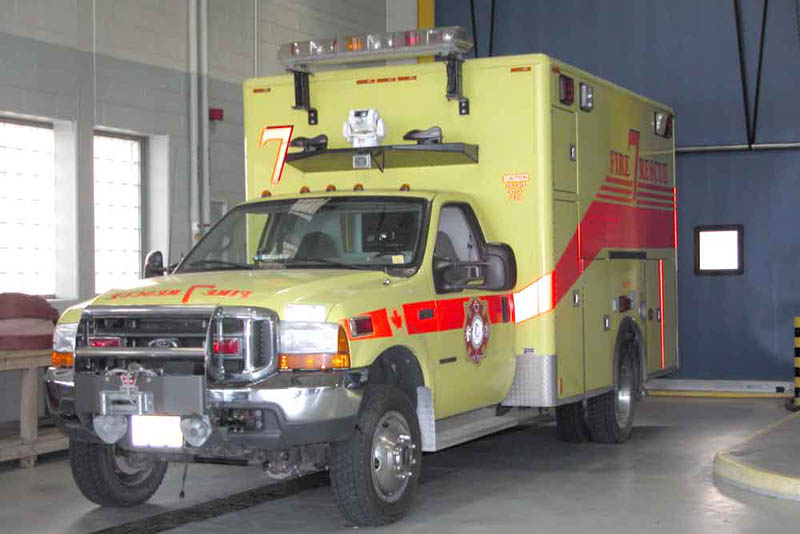
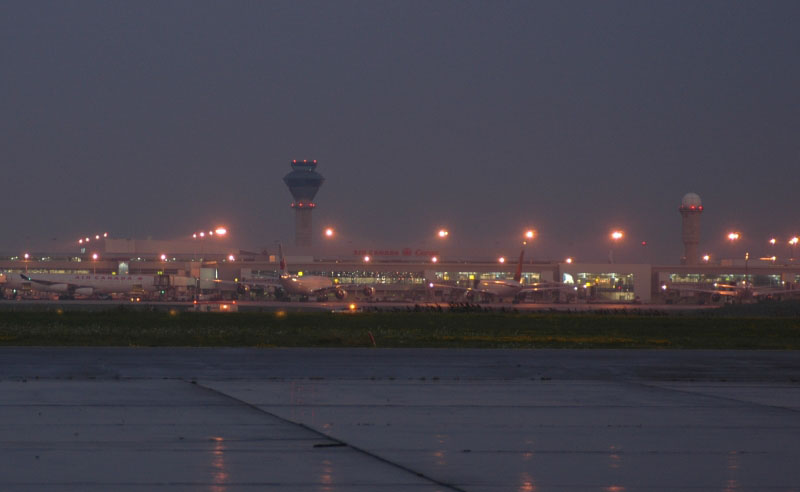
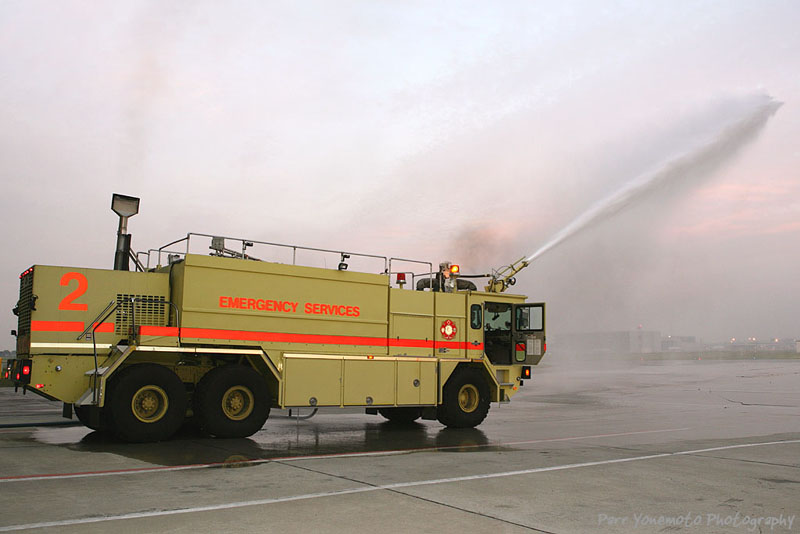
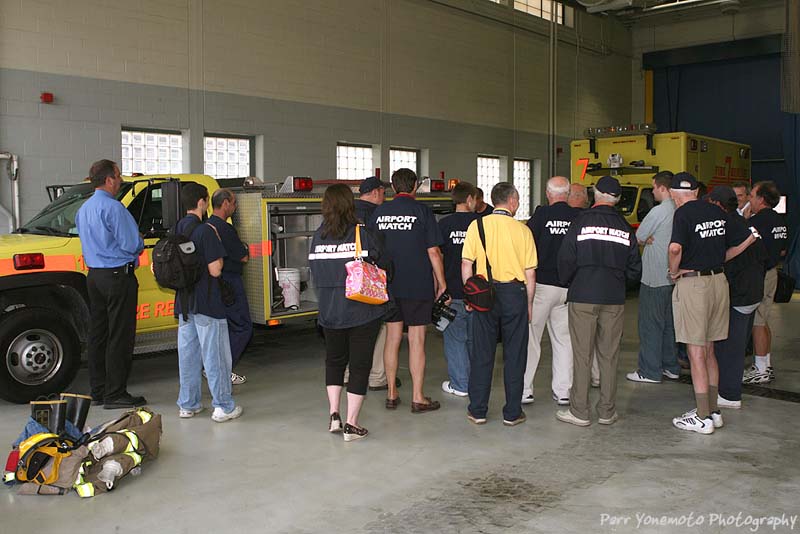

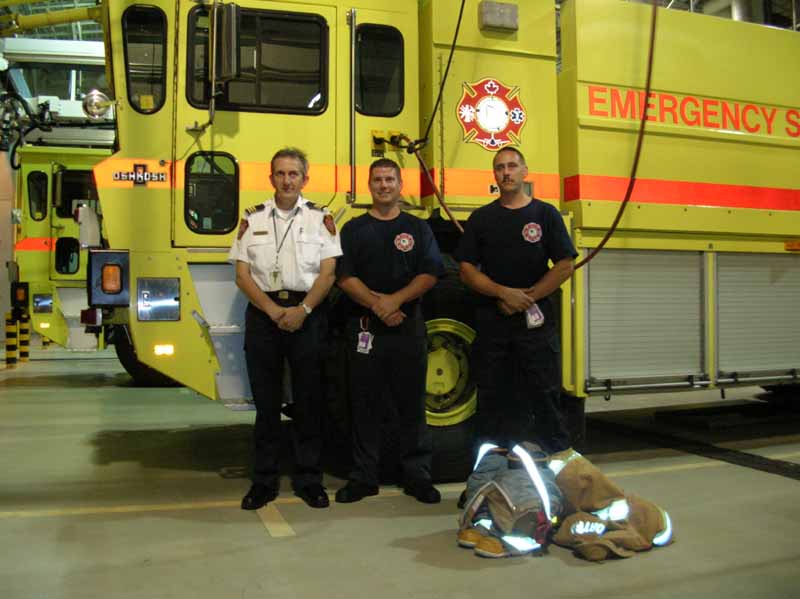
Back to Tours & Events main page |
|